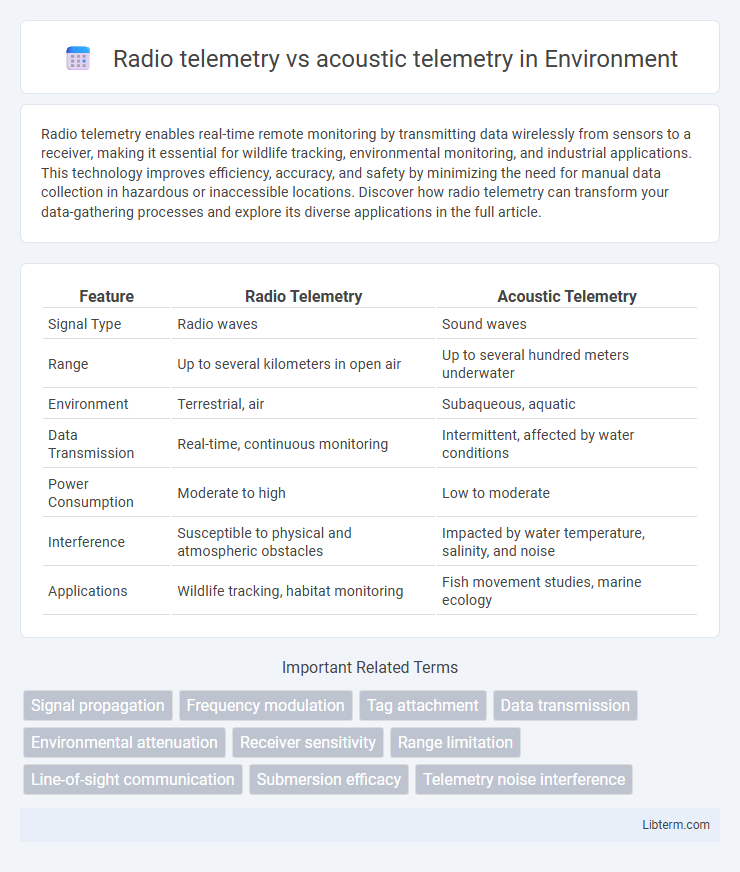Radio telemetry enables real-time remote monitoring by transmitting data wirelessly from sensors to a receiver, making it essential for wildlife tracking, environmental monitoring, and industrial applications. This technology improves efficiency, accuracy, and safety by minimizing the need for manual data collection in hazardous or inaccessible locations. Discover how radio telemetry can transform your data-gathering processes and explore its diverse applications in the full article.
Table of Comparison
| Feature | Radio Telemetry | Acoustic Telemetry |
|---|---|---|
| Signal Type | Radio waves | Sound waves |
| Range | Up to several kilometers in open air | Up to several hundred meters underwater |
| Environment | Terrestrial, air | Subaqueous, aquatic |
| Data Transmission | Real-time, continuous monitoring | Intermittent, affected by water conditions |
| Power Consumption | Moderate to high | Low to moderate |
| Interference | Susceptible to physical and atmospheric obstacles | Impacted by water temperature, salinity, and noise |
| Applications | Wildlife tracking, habitat monitoring | Fish movement studies, marine ecology |
Introduction to Telemetry: Definition and Applications
Telemetry involves the wireless transmission of data collected from remote or inaccessible sources to monitoring equipment for analysis. Radio telemetry uses radio waves to transmit real-time data from devices like wildlife tracking collars or environmental sensors, offering extensive range and rapid communication. Acoustic telemetry employs sound waves underwater to track aquatic animals or monitor submerged equipment, excelling in marine environments where radio signals cannot penetrate.
Overview of Radio Telemetry
Radio telemetry employs radio waves to remotely track and monitor animal movements, providing real-time data over extensive ranges, often exceeding several kilometers. It utilizes lightweight transmitters attached to the subject, enabling detailed behavioral and migratory studies across diverse terrestrial and aquatic environments. Compared to acoustic telemetry, radio telemetry offers increased transmission distances and is particularly effective in open areas where radio signal propagation is unobstructed.
Overview of Acoustic Telemetry
Acoustic telemetry uses sound waves to transmit data underwater, enabling precise tracking of aquatic animals in environments where radio signals cannot penetrate effectively. It consists of implanted or attached acoustic transmitters that emit unique signals detected by submerged receivers, facilitating long-term monitoring of animal movements and behaviors. This technology excels in freshwater and marine ecosystems, providing critical insights for conservation and fisheries management through real-time, spatially accurate data collection.
Key Differences Between Radio and Acoustic Telemetry
Radio telemetry transmits data via radio waves, enabling real-time tracking over long distances in terrestrial and aerial environments. Acoustic telemetry uses sound waves to monitor aquatic animals, as sound travels efficiently underwater, providing reliable data in submerged habitats. Key differences include signal range, medium suitability, and environmental constraints, with radio excelling in air and acoustic optimal underwater.
Signal Transmission and Range Comparison
Radio telemetry transmits signals using radio waves, enabling long-range communication that can extend several kilometers above ground, depending on antenna power and environmental conditions. Acoustic telemetry relies on sound waves, primarily in underwater environments, with signal ranges typically limited to a few hundred meters due to water absorption and noise interference. While radio telemetry offers superior range and faster data rates in air, acoustic telemetry remains essential for subaqueous tracking where radio signals cannot effectively propagate.
Environmental Factors Affecting Performance
Radio telemetry performance declines in dense vegetation and rugged terrain due to signal attenuation and multipath interference, limiting effective range primarily to open areas. Acoustic telemetry effectiveness is influenced by water temperature, salinity, and ambient noise levels, which can degrade signal propagation and detection accuracy in aquatic environments. Understanding these environmental factors is crucial for selecting appropriate telemetry methods for wildlife tracking and aquatic research.
Advantages and Disadvantages of Radio Telemetry
Radio telemetry offers advantages such as long-range signal transmission, ability to penetrate vegetation and obstacles, and the capability to track multiple tagged animals simultaneously. However, it faces disadvantages including limited effectiveness in underwater environments, potential interference from other radio signals, and higher power consumption requiring larger batteries. Its suitability is optimal for terrestrial and aerial wildlife tracking but less effective compared to acoustic telemetry in aquatic habitats.
Advantages and Disadvantages of Acoustic Telemetry
Acoustic telemetry excels in tracking aquatic species due to its ability to operate effectively underwater where radio signals rapidly attenuate, providing precise location data over moderate ranges and in complex underwater environments. Its main advantages include long battery life of transmitters, low power consumption, and resistance to signal interference caused by water conductivity and obstacles. However, disadvantages involve limited range compared to radio telemetry, potential data loss in noisy habitats, and a reliance on receiver arrays, which can be costly and labor-intensive to deploy and maintain.
Typical Use Cases: When to Choose Each Technology
Radio telemetry excels in terrestrial wildlife tracking and environmental monitoring where long-range data transmission and real-time location updates are crucial, such as tracking large mammals in open habitats or monitoring weather stations. Acoustic telemetry is preferred in aquatic environments for tracking fish and marine animals, especially in murky waters or complex underwater terrains where radio signals cannot penetrate effectively. Choosing between the two depends on the habitat and species behavior: radio telemetry for land-based, wide-area coverage, and acoustic telemetry for precise underwater tracking and behavioral studies.
Future Trends in Telemetry Technologies
Future trends in telemetry technologies emphasize enhanced data transmission speed and longer battery life for both radio telemetry and acoustic telemetry systems. Integration of AI-powered analytics and machine learning algorithms is improving real-time monitoring accuracy and predictive maintenance capabilities in environmental and wildlife tracking. Advances in miniaturization and hybrid telemetry systems combining radio and acoustic signals are expanding operational range and reliability in challenging underwater and terrestrial environments.
Radio telemetry Infographic

 libterm.com
libterm.com